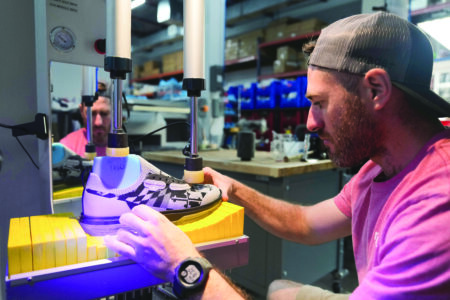Grandparents Teach, too: Hike in leaves and breathe fresh air

Sabin, DaVIS, HETRICK, ANDEREGG, Macalady, walker, darling and Katers
Now is the time to get outside into the fresh air. Although leaves are falling rapidly as days shorten, families have just enough time to teach young children the science and art of leaves with simple activities, everyday materials, and conversation.
You’ll need a bagful of leaves, a paint brush or sponge, paper, five paper plates, a heavy book, white glue, and clear packing tape.
Collecting Leaves
Take a walk and gather a variety of tree leaves, colors, and shapes like oak, maple, and willow. Then discuss how maple trees are shaped like an open hand whereas many oaks are tough, long, and thin with a few fingers sticking out.
Sort before the leaves curl and help children tape a sample leaf on five separate plates. For example: a yellow maple, brown maple, red maple, an oak, and one for damaged leaves. These leaves will label your plates. Now take out a few leaves at a time and help children place leaves on the plate that are similar to the label leaf.
Leaf’s Job
Carry on a science conversation about attributes like color and shape. Explain why leaves turn from green to red, yellow, and brown. The leaf’s main job is to make sugar food for plants to live and grow. They manufacture with part of the air called carbon dioxide, sunlight, and the green chemical pigment chlorophyll in the leaves. There are many library books and free online videos to show this photosynthesis process to children. The food is carried by the trunk to the roots and is stored for the winter.
As sunlight hours become shorter in October the work of the leaves slows down and a layer of cork cells forms across the base of the leaf and closes it off from the tree. The water supply is cut off and it slowly dries and dies. As it dies the other colors that were there under the green like red, yellow, and orange show up. A dry fall produces dull colors. A wet fall has vibrant colors.
Leaf Art
After sorting, place some leaves a thick book to press. Use paper towel sheets to keep leaves from touching book pages. You may first spray leaves with hair spray to help retain color.
After a few days leaves will be flat enough for art. Children may make bookmarks by gluing small leaves or leaflets on paper strips and covering both sides with clear packing tape for great gifts.
Children can also make rubbings by placing leaves under a paper and gently rubbing a flat peeled crayon over the leaf. Veins will show up. Dabbing paint around leaves placed on top of the paper will create a beautiful collage when the leaves are removed. For more see grandparentsteachtoo.blogspot.com and wnmufm.org/learning through the seasons, live and podcasts.
EDITOR’S NOTE: Grandparents Teach, Too is a non-profit organization of elementary and preschool teachers from Marquette, Michigan. The writers include: Jan Sabin, Mary Davis, Jean Hetrick, Cheryl Anderegg, Esther Macalady, Colleen Walker, Fran Darling, and Iris Katers. Their mission since 2009 is to help parents, grandparents, and other caregivers of young children provide fun activities to help prepare young children for school and a life long love of learning. They are supported by Great Start, Parent Awareness of Michigan, the U.P. Association for the Education of Young Children, Northern Michigan School of Education, the U.P. Children’s Museum and the Northern Michigan University Center for Economic Education.





